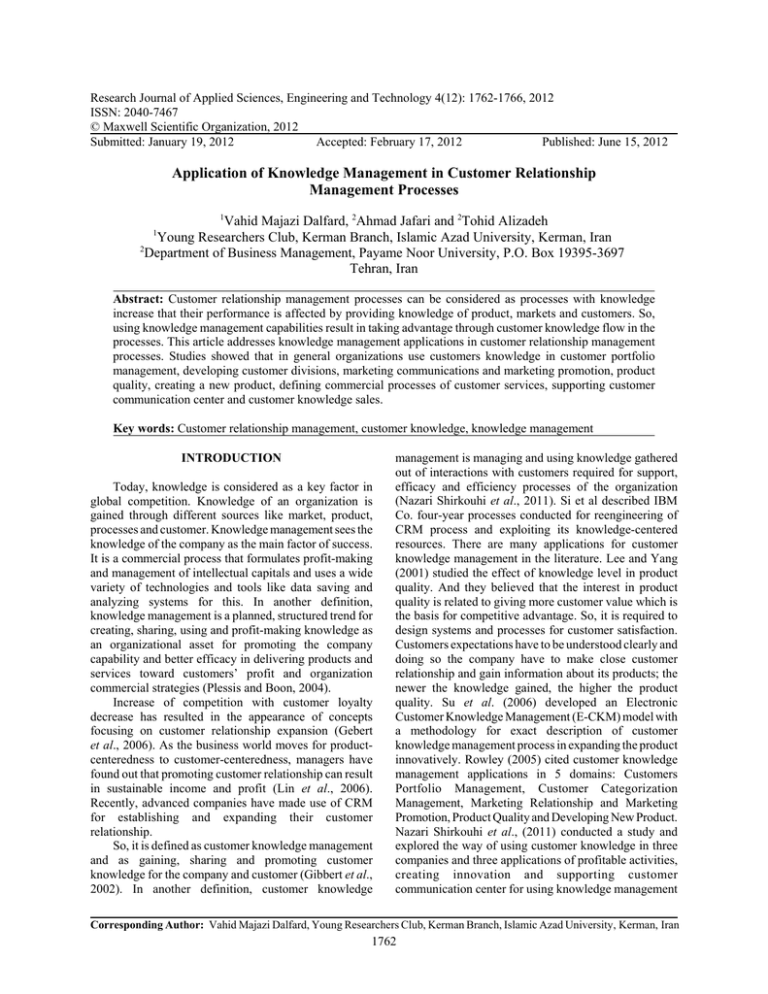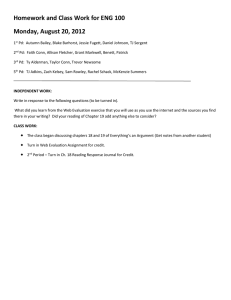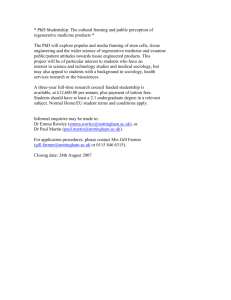Research Journal of Applied Sciences, Engineering and Technology 4(12): 1762-1766,... ISSN: 2040-7467
advertisement

Research Journal of Applied Sciences, Engineering and Technology 4(12): 1762-1766, 2012 ISSN: 2040-7467 © Maxwell Scientific Organization, 2012 Submitted: January 19, 2012 Accepted: February 17, 2012 Published: June 15, 2012 Application of Knowledge Management in Customer Relationship Management Processes 1 Vahid Majazi Dalfard, 2Ahmad Jafari and 2Tohid Alizadeh 1 Young Researchers Club, Kerman Branch, Islamic Azad University, Kerman, Iran 2 Department of Business Management, Payame Noor University, P.O. Box 19395-3697 Tehran, Iran Abstract: Customer relationship management processes can be considered as processes with knowledge increase that their performance is affected by providing knowledge of product, markets and customers. So, using knowledge management capabilities result in taking advantage through customer knowledge flow in the processes. This article addresses knowledge management applications in customer relationship management processes. Studies showed that in general organizations use customers knowledge in customer portfolio management, developing customer divisions, marketing communications and marketing promotion, product quality, creating a new product, defining commercial processes of customer services, supporting customer communication center and customer knowledge sales. Key words: Customer relationship management, customer knowledge, knowledge management INTRODUCTION Today, knowledge is considered as a key factor in global competition. Knowledge of an organization is gained through different sources like market, product, processes and customer. Knowledge management sees the knowledge of the company as the main factor of success. It is a commercial process that formulates profit-making and management of intellectual capitals and uses a wide variety of technologies and tools like data saving and analyzing systems for this. In another definition, knowledge management is a planned, structured trend for creating, sharing, using and profit-making knowledge as an organizational asset for promoting the company capability and better efficacy in delivering products and services toward customers’ profit and organization commercial strategies (Plessis and Boon, 2004). Increase of competition with customer loyalty decrease has resulted in the appearance of concepts focusing on customer relationship expansion (Gebert et al., 2006). As the business world moves for productcenteredness to customer-centeredness, managers have found out that promoting customer relationship can result in sustainable income and profit (Lin et al., 2006). Recently, advanced companies have made use of CRM for establishing and expanding their customer relationship. So, it is defined as customer knowledge management and as gaining, sharing and promoting customer knowledge for the company and customer (Gibbert et al., 2002). In another definition, customer knowledge management is managing and using knowledge gathered out of interactions with customers required for support, efficacy and efficiency processes of the organization (Nazari Shirkouhi et al., 2011). Si et al described IBM Co. four-year processes conducted for reengineering of CRM process and exploiting its knowledge-centered resources. There are many applications for customer knowledge management in the literature. Lee and Yang (2001) studied the effect of knowledge level in product quality. And they believed that the interest in product quality is related to giving more customer value which is the basis for competitive advantage. So, it is required to design systems and processes for customer satisfaction. Customers expectations have to be understood clearly and doing so the company have to make close customer relationship and gain information about its products; the newer the knowledge gained, the higher the product quality. Su et al. (2006) developed an Electronic Customer Knowledge Management (E-CKM) model with a methodology for exact description of customer knowledge management process in expanding the product innovatively. Rowley (2005) cited customer knowledge management applications in 5 domains: Customers Portfolio Management, Customer Categorization Management, Marketing Relationship and Marketing Promotion, Product Quality and Developing New Product. Nazari Shirkouhi et al., (2011) conducted a study and explored the way of using customer knowledge in three companies and three applications of profitable activities, creating innovation and supporting customer communication center for using knowledge management Corresponding Author: Vahid Majazi Dalfard, Young Researchers Club, Kerman Branch, Islamic Azad University, Kerman, Iran 1762 Res. J. Appl. Sci. Eng. Technol., 4(12): 1762-1766, 2012 in customer relationship management processes. We present the theoretical foundation of this study in the following paragraph. After an outline of our research approach we introduce the results of our survey of the status quo of CKM initiatives within organizations. APPLICATIONS OF CUSTOMER KNOWLEDGE MANAGEMENT Using knowledge management capabilities it is possible to employ customer knowledge in the following areas: Customers portfolio management: Concept of customer portfolio is the same as product portfolio (Dhar and Glazer, 2003). In fact, the purpose is to achieve an optimum combination of the customers so that we could have maximum profit. Today, businesses are evaluating the value a customer gives them. Doing so, they use the concept of customer life value (a period in which an economic agency is able to gain profit of a customer) and its respective RFM model. Customer value can be calculated by the latest date of purchase, frequency of the purchase and the money paid for it; the higher the RFM, the higher the customer value. It is expensive to maintain the customer, for instance, in form of cost to certain supplies, marketing relationships and or prizes through loyalty pattern. However, people generally think that gaining customer is less expensive. Businesses are increasingly informed that for a particular group of customers, customer maintenance costs might be more important than the business long-term profit making. So, using customer knowledge, it is possible to evaluate whether the customer is making profit for the organization or not and whether rewarding the customer results in his loyalty maintenance regarding the fact that he is located in non-preferred customers list and it is not required to encourage him. So, if the customer is profitable with high life span, the organization is probably interested in any knowledge of that customer even if it gains it with difficulty, if customer is non-preferred and his concern is not of importance to the organization so as to be provided by an ordinary package by the organization (Rowley, 2005). Customer categorization management: Personal data in registering forms and the like are important in categorizing customers which might be done based on number of children in a family, age, income, geographical location and a set of other factors. The factors can be used by transaction data for producing typical transaction patterns for marketing and promoting a new product for predictable needs of these parts. In fact, a product and communicative strategy is formulated for these parts (Rowley, 2005). In late 1990s, Credit Suisse Co. conducted its financial products marketing without categorizing the customers. So, it was not possible to evaluate a particular activity’s success in terms of customers groups. So, it began a project aiming at targeting any marketing activity of the product based on specific needs of the section customers so that product sales ration can increase with marketing activity. The company realized that it had to gain the knowledge of customer base contact dates and the product they had used to be able to recognize profitable customers relationships. In 1999, the company decided to introduce a data storage the bank gained for knowledge organization of its customers’ product use. If a product activity is to get started, a target group is selected and the possibility of the customer buys that group is determined by data analysis methods. With the data, customer groups are made based product priorities, a relationship strategy and a product is determined for each group. Then, a list of target customer is prepared and delivered to the managers of the group. Finally, sales success feedbacks are provided for further promotion of market divisions for marketing department (Nazari Shirkouhi et al., 2011). Marketing relationship and marketing promotion: Personnel contact details allow the organization to locate the customer and possibly communicate through multiple channels of workplace addresses, mobile sets and internet. Transaction data usually provide indices of the products customer buy and allow organizations like a supermarket to encourage the customers to try the substitutes. All of these generally focus on what really values for the customers and result in their supply value increase. So, advantages like marketing relationships, discount, product promotion, more suitable and more desirable purchase and … (Rowley, 2005). Product quality: Lee and Yang (2001) studied the effect of customer knowledge level and employees cooperation in knowledge distribution in product quality. They considered two aspects of knowledge management and knowledge distribution; knowledge gain as knowledge management process beginning and knowledge distribution as the end. They argued that the logic of interest in product quality is in providing more value to customers. And more customer value is the basis of competitive profit. So, it is required to design processes helpful in creating customer satisfaction. Customers expectations must be clearly understood for the company be able to focus on customers, it has to establish close relationship with them and persistently gain their knowledge of the company’s products. Their study demonstrated that the more customer knowledge of a product, the higher the product quality. The level of requesting customer knowledge is in form of mutual relationship with the customers, the interpretation they had of the company’s product, stimulating them to offer product improvement ideas, 1763 Res. J. Appl. Sci. Eng. Technol., 4(12): 1762-1766, 2012 receiving information and analyzing them regularly and further customers feedback comparing to rivals. Linderman et al. (2003) also focused on customer from quality management view. They used Nonaka quadratic knowledge creation theory and demonstrated that the activities of quality management which focus on customer result in knowledge creation in the organization. And the knowledge must be used in creating profit. The results require the managers and professionals of developing product to not only consider knowledge gaining processes in developing the product, but also consider current knowledge management questions deeply so as to use total NPD potential of the organization. Developing new product: Transactions data profiles of each part of market can demonstrate product lines related to particular sections. It might offer new product opportunities or current product promotion paths. Also purchase profiles create insight into brand priorities, design, quality, price might be effective in new product design (Rowley, 2005). Siemence Co. as an active global supplier of mobile communication solutions has seven global communication centers which receive 6 million contacts and an average 400000 emails and 70000 scripts each year. In the past, local services organizations acted separately. Although complain management process was conducted by systems, customer services seemed to respond customer complaint and serviced requests as efficiency. There was no analysis done on high volume of contacts, mails and written questions for promoting innovation. Also, no agreement was on complaining about paying attention to the customer or connecting to global department of the product development. So, the company decided to use a base for customer compliant entry and feedback to product promotion and innovation. High competition pressure in mobile communication market, shorter product life and customer expectation increase regarding product performance and quality were the main stimulations of the company in considering its customers through KM tools. Now, all customer’ requests are collected and saved in a central knowledge data base at central office of Seimence. Product development department is also located in central office and department of paying attention to the customer contacts each one individually to register their particular ideas and consider them in product development. Doing so, the company optimized technological trends and as a result created knowledge of prospective how about innovation needs in product and customer service. This way, it improved complaint management support both for the branch of serving the customer on website and for Seimence employees at contact centers and local stores. The main output was the transformation of customer feedback to new product qualities both during production and in the market. An example of the important side effects is that Seimence observed that final users who complained and the company took action to directly evaluate their futures for innovations in the product transferred to loyal and satisfied customers (Nazari Shirkouhi et al., 2011). Defining commercial processes of serving customers: Customers knowledge and their involvement in a business based on its own filed and duration for gaining information about mutual planning can be used. For example, in serving the customer, it is possible that address knowledge create insights regarding whether customer is able to return goods easily. Each record of previous complaint can be used for prioritizing complaint solution. Recommendation on using a product like TV or a new computer can be based on any record in previous experiences with customers (Rowley, 2005). Supporting customer communication center: All companies need a unit to respond to their customers. For this unit to be able to serve its customer with high quality and speed requires real time and integrated customer knowledge. Otherwise, if a customer refers to the organizations for several times, he will still be new to this section and need to retell many problems again. It results in customer’s dissatisfaction and service delivering time increase. For example, Union Investment-c large investment company in Germany-describes the importance of knowledge for service management under CRM process. There is a Customer Communication Center (CCC) in Union Investment using communication channels like phone, fax and email for customer service delivery and 120 employees serve bank employees and customers with a wide spectrum of subjects regarding complex financial issues. First, the employee used different organizational units information gathered and approved by interior information supporter. Using the information, they had to organize part of the work related to themselves namely new employees did not have access to previous information; the more information, the worse the problems. Also, complicated process of converting documents into the format based on web created significant costs. For reforming the problematic conditions, company executed a project aiming at eliminating current plan limitations, unfolding knowledge and a review that made content search possible. Union Investment decided to respond to the challenges with a new content management. The decision included a conversation tool based on new patterns created in official applications and could create HTML content with a general automatic design style. The new method enabled editors in direct release of new content in official applications and also provided a general view of 1764 Res. J. Appl. Sci. Eng. Technol., 4(12): 1762-1766, 2012 the documents. Content management system provided a search to support CCC staff work. A compatible review structure was also designed. Based on CCC staff deep analysis, edition processes, new structuring and low time section of accessibility of the information existing on knowledge platform are of important factors. So, the employees can provide faster responses with higher quality. Saving the process time, it is possible to serve more customers and service level and waiting time will be reduced. Because of removing works regarding existing content convert in information support department, cost and time required for maintaining new platform are reduced. And, it makes it more feasible to focus on one thing the staff need and release operational costs of editors are decreased (Nazari Shirkouhi et al., 2011). Customer knowledge sales: Many organizations have so much unnecessary customer data. All the organizations have high potential for producing information and knowledge from data bases that might not have any direct advantage for them. In this case they can sell the data (Rowley, 2005). Old Mutual the largest insurance company at South Africa gathering patience knowledge such as health care directly and using electronic methods (instead of just relying on the doctors). Sin the company, customer knowledge is used for reviewing and displaying medical insurance applications and above all for creating new medical insurance products. When patients health care forms are filled manually by doctors, they have to replaced with forms filled by the patients. It results in more information and also entry of patience knowledge. However, the ethical issues and professional knowledge (information security, patient and doctor relationship) have to be managed closely, but the patients knowledge like their own conditions, treatment, effect of particular drugs, medical insurance companies acceptance and their products for pharmacy companies, insurance companies, doctors and other partners in health care management industry are of value (Gibbert et al., 2002). Amazon Co. gains customers knowledge easily through providing book reviews, the customers own order date and book offers to any particular person regarding previous purchase record. It has effectively provided a platform for the book lovers interested in communicating their knowledge. In particular, comparing to other companies trying to encourage the employees by reward systems to share their knowledge, it has performed very well. The customers shared not only their comments but also even their jokes and points in a friendly way. They also offer tips on studying more about the subject and create incentive and even stimulations for the customers to research and buy the sources. Customers knowledge can be shared with the authors of the new books and they will provide new ideas for publishing more and the potential for the market. So Amazon can sell the knowledge to publishers and authors and make profit. The knowledge is not only employee’s, but also customers’ knowledge resulting in value creation through growth and innovation, rather than value creation through saving costs (Gibbert et al., 2002). DISCUSSION Customer knowledge is a great source of profit making. Companies can recognize each customer’s value and choose suitable strategy using customer knowledge. It is also possible to divide the market based on customers’ knowledge and formulate product and strategy for each section of the market. So, production and sales are more purposeful and sales and profit making will have lower risks. Customer knowledge can be used for better customer relationship. Since quality is in fact being compatible with customers expectations and preferences, so it can be sad that customer knowledge is considered a crucial source for gaining higher product quality. Customers’ expectations have to be understood clearly. For the company to get focused on the customers this way, it has to make close relationship with them and gain persistently their knowledge of the products. Companies can use each market section respective transactions data profiles in developing a new product. Because using them they can recognize the product selected by particular section in terms of price, brand and design and quality. Customer feedback is useful in this regard like a new computer or TV based on customers’ suggestions (Rowley, 2005). Using customer knowledge it is possible to increase service quality for example it can be determined by address whether customer is able to return the goods or not. Knowing the answer of the question can help with providing the customer with better services. It can also be used by communication center and create customer satisfaction. For example, if customer knowledge is not managed correctly and not provided the organization staff timely, a customer may have to give them similar information at each contact. In the end, if we suppose that the organization has no use of customer knowledge, it can sell it to other organization need it and make money this way; of course by meeting security and ethical considerations and also having customers’ permission. Otherwise the organization will lose customers’ trust and obviously the customers. CONCLUSION Today, knowledge is an important profit making source for companies. It has different sources like markets, products, orders, suppliers, customers and …. Researches have demonstrated that successful companies use knowledge management in profit making. In this article, eight knowledge management applications were discussed and respective examples were addressed. The 1765 Res. J. Appl. Sci. Eng. Technol., 4(12): 1762-1766, 2012 article results in creating insight in researchers and professionals regarding value and significance of customers knowledge and how it is profitable. As a result of our research effort, we established a conceptual framework for knowledge-based CRM. However, the data derived from our survey did not intend to investigate CKM in any hypothetic and/or deductive way. This constitutes two limitations within our research. Likewise, our case study findings have to be substantiated on a broader basis. The proposed conceptual framework therefore needs follow- up research and has to be further tested by means of qualitative and quantitative data, particularly to ensure the generalizability of the framework. We will also pursue the opportunity to undertake longitudinal studies with the same organizations in order to discover if the findings hold true over time. This should also lead to a refinement of the proposed framework, leading us from a macro to a micro level. REFERENCES Dhar, R. and R. Glazer, 2003. Hedging customers. Harvard Bus. Rev., 81(5): 86-92. Gebert, H., M. Geib, L.M. Kolbe and W. Breaner, 2006. knowledge-enabled customer management. J. Knowledge Mnag., 7(5): 107-123. Gibbert, M., M. Leibold and G. Probet, 2002. Five style of customer knowledge management and how smart companies use them to create value. Eur. Manag. J., 20(5): 459-469. Lee, C.C. and J. Yang, 2001. The knowldege value of customer and employees in product quality. J. Manag. Dev., 20(8): 691-704. Lin, Y., H.Y. Su and S. Chein, 2006. A Knowledge enabled procedure for customer relationship management. Ind. Market. Manag., 35: 446-456. Linderman, K., R.G. Schroeder, S. Zaheer and A.S. Choo, 2003. Six Sigma: A goal theoretic perspective. J. Oper. Manag., 21(2): 194-203. Nazari Shirkouhi, S., A. Ansarinejad, S. Miri-Nargesi, V.M. Dalfard and R. Kamran, 2011. Information systems outsourcing decisions under fuzzy group decision making approach. Int. J. Inf. Tech. Decision Making, 10(6): 989-1022. Plessis, D. and J.A. Boon, 2004. Knowledge management in ebusiness and customer relationship management: South African case study findings. Int. J. Inform. Manag., 24: 73-86. Rowley, J., 2005. Building brand webs: Customer relationship management through the Tesco Club card loyalty scheme. Int. J. Retail Distri. Manag., 33(3): 194-206. Su, C.T., Y.H. Chen and D.Y. Sha, 2006. Linking innovative product development with customer knowledge: A data mining approach. Technovation, 26(7): 784-795. 1766



